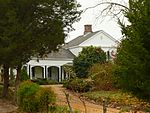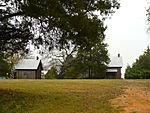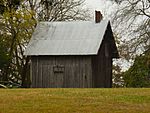Faunsdale Plantation facts for kids
Quick facts for kids |
|
|
Faunsdale Plantation
|
|

The main house at Faunsdale Plantation in 2008
|
|
| Location | near Faunsdale, Alabama |
|---|---|
| Area | 13 acres (5.3 ha) |
| Built | 1844 |
| Architectural style | Greek Revival, Carpenter Gothic |
| MPS | Plantation Houses of the Alabama Canebrake and Their Associated Outbuildings MPS |
| NRHP reference No. | 93000602 |
| Added to NRHP | 13 July 1993 |
Faunsdale Plantation is an old, important farm near Faunsdale, Alabama. The nearby town of Faunsdale was named after this plantation. It's located in Alabama's "Black Belt" region. This area was known for growing lots of cotton.
Before the Civil War, many people were forced to work here. Up to 186 enslaved African Americans grew cotton on this land. Some of the cabins where these workers lived are still standing. These cabins are important examples of housing for enslaved people in Marengo County. They are also some of the last left in Alabama.
The main house was added to the National Register of Historic Places on July 13, 1993. It is part of a group of historic plantation homes.
Contents
What Faunsdale Plantation Looks Like
The main house at Faunsdale Plantation is a two-story building. It is made of wood and has a simple Greek Revival style. It has a pointed roof with one-story wings on each side.
The small cabins nearby were built around 1860. These cabins are also made of wood. They have steep, pointed roofs and fancy carved decorations. This style is called Carpenter Gothic.
Records of Enslaved Families
Faunsdale Plantation is special because detailed records were kept about the enslaved people. These records show that the Harrison family enslaved about 99 people in 1846. This was a few years after they bought the property.
By 1857, the number of enslaved people had grown to 161. A list from 1864 shows that 186 people were enslaved by Louisa Harrison, the owner's widow. These people likely formed at least 35 families.
The records also listed some of the surnames used by enslaved people. These included Barron, Brown, Francis, Harrison, and Washington. Sadly, by the end of 1864, 14 enslaved people had died from illnesses. These diseases included typhoid fever and measles.
History of Owners and Workers
In the 1830s, Pearson and H. A. Tayloe bought this land. This happened after indigenous Creek people were forced to move from the area. The new owners used enslaved African Americans to clear the land.
In 1843, Dr. Thomas Alexander Harrison bought 960 acres of land. He named his new property Faunsdale Plantation. He named it after Faunus, an ancient Roman god of forests and fields.
Like other plantation owners, Dr. Harrison brought many enslaved people from Virginia. This was part of a huge forced movement of about one million enslaved people. They were moved to the Deep South to work on new plantations.
Dr. Harrison's wife, Louisa, was an educated woman. She had a private teacher and went to a boarding school. Dr. and Mrs. Harrison had one daughter, Louise.
After Dr. Harrison died, Mrs. Harrison built a chapel at Faunsdale. This chapel was for the enslaved workers. Other plantation owners in the area also built chapels for the people they enslaved. In 1864, Louisa Harrison married again to Rev. Stickney. They lived at Faunsdale.
St. Michael’s Church
In 1844, Dr. Harrison and his wife, Louisa, gave one acre of their land. They wanted a log church built across from their house. In 1846, the first Episcopal bishop in Alabama visited Faunsdale. He noted that Louisa Harrison taught the enslaved people. She read church services and taught their children.
In 1852, the church was renamed St. Michael’s Episcopal Church. By 1855, a new Gothic Revival-style church building replaced the log one. Enslaved African Americans likely provided all the skilled labor for this new church.
A churchyard for burials was started in 1858. Dr. Harrison was the first person buried there. Starting in 1860, enslaved people and later, freedmen (formerly enslaved people) were also buried in this churchyard. The church building was moved to the town of Faunsdale in 1888. A tornado destroyed it in 1932. However, the churchyard on the plantation grounds continued to be used for burials.
Gallery






